Cradle to Cradle Certified®
With the Cradle to Cradle certification of our Colortec and Axminster carpet solutions we have achieved strong visible recognition of our concentrated efforts to run our business conscientiously.
With the Cradle to Cradle certification of our Colortec and Axminster carpet solutions we have achieved strong visible recognition of our concentrated efforts to run our business conscientiously.
Embracing a commitment to sustainability is more than just a vision—it’s a strategic imperative. The Cradle to Cradle certification has become our guiding light and instrument, steering our course towards focused, continual, and holistic sustainable business development, in the recognition that reel green transition is a long, tough journey and requires transformation of fundamental systems and structures.
The Cradle to Cradle framework resonates with our values, pushing us beyond the conventional notions of sustainability. It’s not just about reducing harm; it’s about creating a positive impact at every stage of a product lifecycle. This certification serves as more than just a stamp of approval; it’s a roadmap for innovation and excellence. By adhering to the rigorous and science based standards set by the independent Cradle to Cradle Products Innovation Institute, we are compelled to constantly evaluate and elevate our processes, materials, and social responsibility. It’s a tool that empowers us to push boundaries, rethink paradigms, and pioneer sustainable solutions.
In essence, the Cradle to Cradle certification has become more than a credential – it’s a catalyst for change, not only within our own organisation but within our value chain. It propels us forward on our journey towards a regenerative and responsible future, where sustainability isn’t an option but a license to operate.
We have not yet reached the finish line and we expect the destination to change along the way. The journey has started, and we have strategies and action plans to constantly improve on all parameters. We are ambitious and set a high standard for quality and environmental and social responsibility – at the same time we want to ensure that our products are available to a wide customer segment in order to achieve the greatest possible impact through a competitive price level.
The most ambitious and actionable standard yet for designing and making products today that enable a healthy, equitable, and sustainable tomorrow.
Dansk Wilton is among the first companies to certify our carpet solutions according to the new and more ambitious version 4.0 of the Cradle to Cradle Certified® Product Standard – the most ambitious and actionable standard yet for designing and making products today that enable a healthy, equitable, and sustainable tomorrow.
Cradle to Cradle Certified Version 4.0 reflects significant advancements in the knowledge and understanding of what it takes to make products with a positive impact on people and planet today, and tomorrow.
Version 4.0 of Cradle to Cradle Certified builds on the legacy of previous versions of the standard by better equipping brands, retailers, designers and manufacturers with guidance and best practices for choosing safer materials, driving meaningful innovation, and creating products, systems and business models that have a positive impact on humans and the environment today, and in the future.
Cradle to Cradle Certified Version 4.0 features new and enhanced requirements in all performance categories, including:
We believe that the documentation requirements and a science-based approach, rather than mere claims, is increasingly crucial for effective engagement in sustainability initiatives.
Our aim to address and handle end-of-life carpet waste as a resource led us to the Cradle to Cradle Certified® standard, and it became even clearer that true sustainability extends beyond product circularity. Recognising the potential environmental and human health risks posed by processing materials including harmful substances and the importance of ethical working conditions, we understand that despite the increased complexity, embracing all dimensions of sustainability is the only responsible path forward.
Unlike many other sustainability certifications and carbon footprint objectives that focus on only one aspect, Cradle to Cradle Certified® takes a more holistic view, considering and balancing all dimensions of sustainability.
One compelling aspect of the Cradle to Cradle certification is its insistence on setting ambitious goals, however, it doesn’t just stop at stating intentions but demands a commitment to real change. This certification requires companies to not only articulate their sustainability aspirations but also back these up with robust strategies and action plans. This ensures that our sustainability efforts are not merely token gestures but represent a genuine commitment to making a positive impact on the environment and society.
Moreover, Cradle to Cradle Certified® provides a guideline for development that is rooted in scientific proof. This means that our sustainability initiatives are not based on subjective definitions or purely to gain a competitive advantage. Instead, they are founded on scientific evidence, ensuring that we are guided in the right direction within all areas of the certification.
Cradle to Cradle Certified® also offers the advantage of providing documentation and third-party validation of our sustainability claims. This transparency not only enhances our credibility but also serves as an assurance to our stakeholders that our commitment to sustainability is genuine and measurable. The Third-party validation adds an extra layer of accountability.
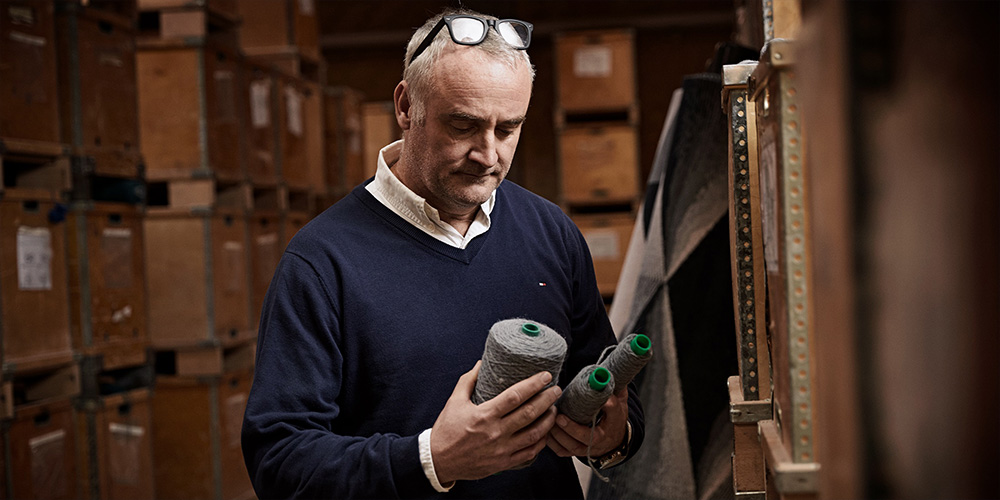
In brief, our company’s dedication to sustainability finds a seamless match in the Cradle to Cradle certification. This certification embraces a comprehensive strategy, establishing ambitious objectives supported by actionable plans for continual enhancement. Grounded in scientific evidence, it emphasises transparent documentation and third-party validation. This certification serves as a robust framework, aiding not only in achieving our own sustainability objectives but also in reinforcing our customers’ commitment to responsible business practices. Quite specifically, Cradle to Cradle Certified® products mean extra credits in several green building schemes.
The following gives an insight into what the Cradle to Cradle certification entails and what it means for the way we do business – and thus, what guarantee it gives our customers when they choose our carpet solutions for their projects.

The fundamental aspect of the Cradle to Cradle certification revolves around the overarching accountability concerning the environment. This serves as an essential element for obtaining the certification. Consequently, the general requirements outlined in the Cradle to Cradle Certified® Product Standard include:
Our environmental management system comprises our policies, strategies, procedures, and action plans and serves as the foundation for continuous improvement, tailored to accommodate both our ambitious goals and the scale of our company.
The certification acts as verified documentation for our clients, affirming their commitment to responsible sourcing. It seamlessly integrates into our clients’ sustainability framework and reporting, enhancing their strategic objectives in sustainability.
“Our Cradle to Cradle certification guarantees that our carpets adhere to stringent environmental and sustainability standards and in this way we want to support the hospitality industry in their focus on increased sustainability and resource management.” – Søren Sonne, CEO
In addition to the general requirements, the Cradle to Cradle certification embraces 5 categories which ensure a broad and holistic approach to sustainability:
Category intent according to the Cradle to Cradle Certified® Product Standard Version 4.0.:
Chemicals and materials used in the product are selected to prioritise the protection of human health and the environment, generating a positive impact on the quality of materials available for future use and cycling.
The material health assessment within the Cradle to Cradle certification is aligned with legislation in both the EU and the USA but goes beyond that.
The certification is notable not only for identifying substances absent in the product but for a more in-depth approach that involves mapping and evaluating all included substances, right down to the individual ”Chemical Abstracts Service number” (CAS#), a unique and simple indicator for chemical compounds. In cases where suppliers cannot provide CAS numbers, such as with recycled materials, where traceability challenges may exist, the materials undergo testing according to certification requirements to ensure no traces of substances surpass the permitted limit specified in the ”Restricted Substances List”, forming the basis for material screening.
Additionally, organic materials are tested for residues of both heavy metals and pesticides, ensuring that the applicable thresholds for listed restricted substances are not exceeded in any homogeneous material subject to review in a certified product.
Our material mapping and assessment rely on extensive data collection conducted by Vugge til Vugge, a Cradle to Cradle Accredited Assessment Body. The collected documentation includes:
Our carpets undergo screening against the comprehensive Restricted Substances List, which includes worst-in-class chemicals such as PVC, PFAS, Phthalates, and heavy metals.
This data is gathered from Tier 1, Tier 2, and Tier 3 suppliers as necessary, ensuring compliance for the substances used in the manufacture of our carpets. Full disclosure entails specifying any chemical substance present in the material, regardless of concentration, by CAS#.
The mapping and assessment serve as the foundation for an optimisation strategy aligned with the requirements at different levels of the Cradle to Cradle certification. For Dansk Wilton, this entails collaborative efforts with our primary suppliers to drive continued development.
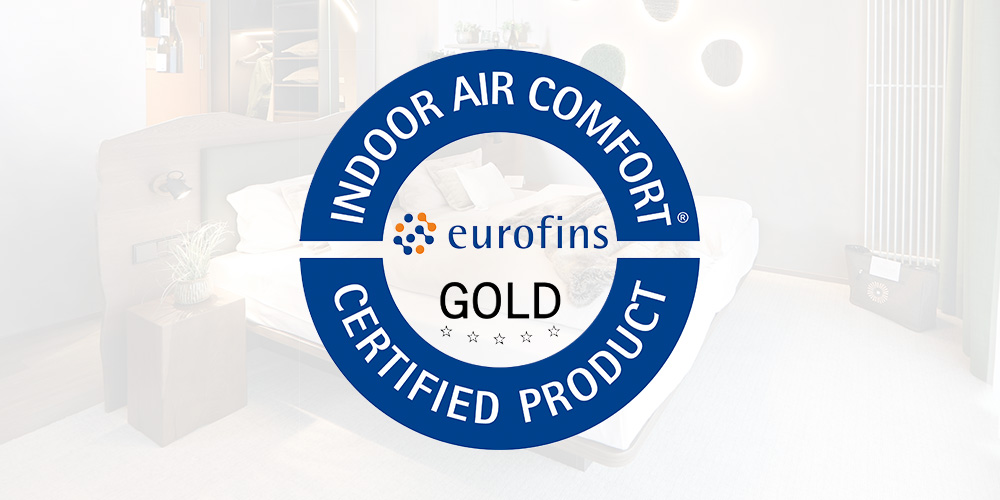
The use of chemical substances can impact the indoor air quality of buildings or ships, prompting the testing of building materials and interiors for volatile organic compounds (VOCs). VOCs are released as gases from certain solids or liquids and encompass various chemicals, some of which may pose short- and long-term health risks. Indoor concentrations of many VOCs tend to be consistently higher (up to ten times higher) than outdoor levels.
The Indoor Air Comfort Gold certification ensures that a product meets stringent requirements for low emissions, serving as both a quality assurance and a contribution to fostering a healthy indoor environment. Eurofins Indoor Air Comfort Gold consolidates the most relevant emission specifications and requirements in Europe within a single certification. It complies with a wide range of material- and construction certifications. Contact us for further information and test reports.
All carpets from Dansk Wilton have achieved highest possible level of certification: Indoor Air Comfort Gold. Requirements are product specific – for details please see the specifications from Eurofins.
As environmentally certified products, Colortec and Axminster support our customers’ focus on environment-friendly solutions. Quite specifically, Cradle to Cradle Certified® products mean extra credits in LEED, WELL v2 and Green Star certified buildings. In that way our Axminster and Colortec carpet solutions make a positive contribution to sustainable building.
Category intent according to the Cradle to Cradle Certified® Product Standard Version 4.0.:
Product packaging meets high product circularity standards at the entry level of certification, ensuring alignment with the Cradle to Cradle principles for these typically non-circular product types.
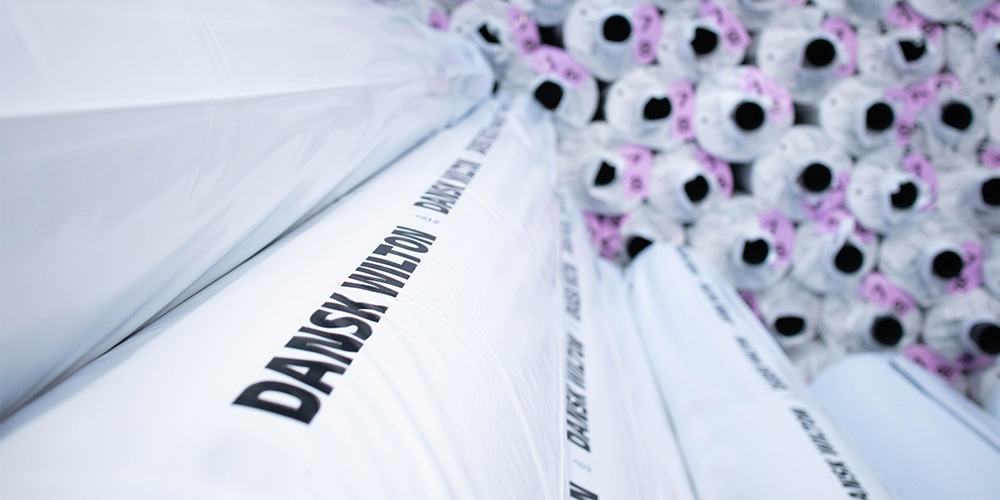
Cradle to Cradle Certified® not only map and assess the material health of the product itself, it also covers the packaging of our carpet rolls. For our packaging specifically, this covers:
Data on the material has been collected and suppliers signed the Restricted Substances List (RSL). The carpet tubes were tested for compliance with the RSL as they contain non-traceable recycled content.
In the below table all packaging materials are listed:
HDPE = High-density polyethylene. LDPE = Low-density polyethylene. In the Cradle to Cradle Certified® User Guidance, only HDPE plastics are categorised as ”commonly recyclable.” Consequently, our carpet tubes are specifically acknowledged for their high-value technical cycling potential. Despite the global increase in recycling of LDPE, it is currently not classified as commonly recyclable according to the guidelines. We anticipate ongoing developments in LDPE recycling systems worldwide, which may eventually lead to LDPE being recognised as ”commonly recyclable,” considering it is the most widely used plastic type globally.
We strongly advise our customers to responsibly recycle the packaging materials in accordance with their local waste handling systems if possible. Proper disposal and recycling contribute to environmental sustainability for the packaging materials.
Category intent according to the Cradle to Cradle Certified® Product Standard Version 4.0.:
Products are intentionally designed for their next use and are actively cycled in their intended cycling pathway(s).
In the pursuit of sustainable and environmentally responsible practices, product circularity stands as an ideal, guiding the way towards a future where products and systems are not just conceived, but comprehensively designed, with the entire lifecycle in mind.
This certification category covers product design, emphasising the integration of renewable and recycled content from the very outset. However, in the spirit of cradle-to-cradle thinking, it goes beyond mere material choices, encouraging the creation of products that are not only eco-friendly in their inception but also considerate of their end-of-use scenarios.
In this category, innovation meets responsibility as designers and manufacturers are challenged to envision products that not only serve their immediate purpose but also contribute to a circular economy.
The Cradle to Cradle certification aims to not only ensure the certified product becomes a resource after its first intended use but also to foster increased demand for materials in general that contribute to a circular economy.
We contribute to increasing the demand for circularly sourced materials by incorporating more cycled or renewable materials into our products. This helps close the loop and promote the circular economy, leading to a reduction in the negative impacts associated with the use of virgin and non-renewable materials. In the certification, Cradle to Cradle assess natural renewable resources eligible for biological cycles on par with recycled materials integrated into technical cycles.
In line with the Cradle to Cradle certification requirements, we have evaluated our performance and established improvement goals. The table below provides an overview of the materials in our carpets, specifying the content of renewable and recycled materials and outlining our improvement objectives:
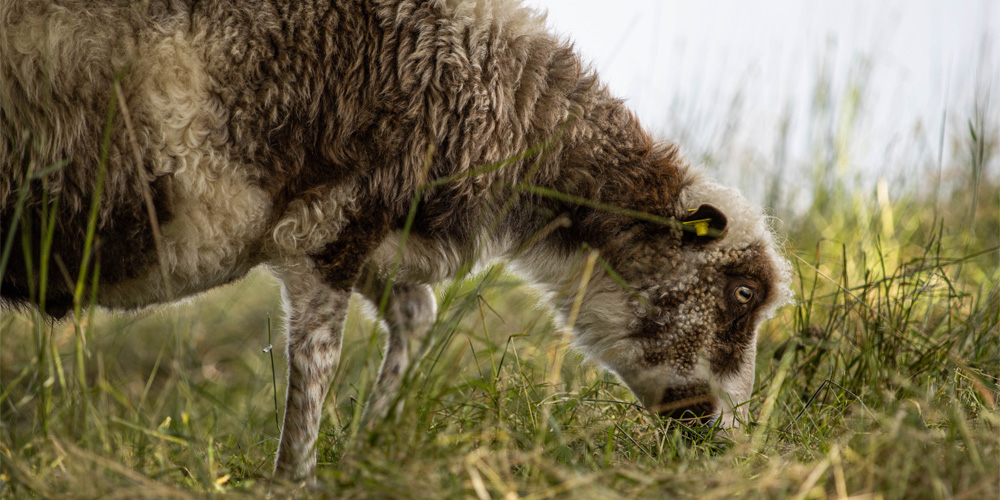
We are in an ongoing dialogue with our suppliers regarding virgin materials to pursue the integration of recycled or renewable content. It is not an easy task, as the industry is dominated by traditional norms and common standards.

As the name suggests, The Cradle to Cradle certification focuses on designing products for continuous cycles, aiming to create value beyond the traditional “cradle to grave” approach. This concept considers the entire life cycle of a product, including its end-of-use phase. However, implementing a fully circular business model is complex and cannot be achieved overnight. We do not currently offer a commercial take-back solution, but we are actively working towards making it a reality.
Although Cradle to Cradle Certified® products may not include a take-back scheme, the certification establishes clear requirements for developing strategies, action plans, and targeted initiatives to promote circularity.
When addressing end-of-life scenarios and reimagining waste as a valuable resource, the Cradle to Cradle certification serves as a guiding framework for companies. It establishes criteria and requirements across various certification tiers, including mandates for employee training and the pursuit of collaborative partnerships conducive to circular business practices.
At Dansk Wilton, we actively engage in identifying and implementing diverse solutions for recycling our carpets at the end of use. This field is still in its early stages, with few technologies currently available for maximising resource utilisation.
We understand that tackling the challenges associated with potential end-of-use scenarios won’t happen overnight. However, we actively participate in these initiatives and pilot projects to explore opportunities and advance toward implementing effective solutions.
RE:SHAPE – a circular mindset and exciting collaborations
In collaboration with partners, we have innovated various materials utilising recycled carpet fibers, spanning from felt to diverse iterations of solid boards. We named the material RE:SHAPE.
Recognizing that repurposing waste is meaningful when the end products find practical applications, we are dedicated to advancing new product lines. Our focus lies in integrating these materials into the realm of interior design, facilitating their reuse in establishments like hotels and cruise ships in fresh incarnations. Through diverse projects, we have headed numerous captivating innovations, including kids’ furniture and architectural signage solutions.
Explore more about the process of transforming carpet fibers into RE:SHAPE material and learn more about the innovative products based on recycled carpet fibers.
For inquiries regarding our recycling initiatives, feel free to reach out to us.
As we strive to address end-of-use challenges through recycling initiatives and the conversion of carpet waste into RE:SHAPE materials, our commitment extends to optimizing the utilization of production waste in general. Our business model has always prioritized waste minimization at every stage of the process. Our technical designers meticulously calculate project requirements to optimize material consumption.
We exclusively manufacture customer orders, thus eliminating the risk of ”dead stock” collection items.
Furthermore, regarding our yarn consumption, we methodically calculate yarn usage with the aim of minimizing waste in the first place. Despite these efforts, waste generation is inevitable, yet we consistently seek innovative solutions.
Residual yarn, being of premium quality, is regarded a valuable asset and we retain sizable yarn batches for future use and have established partnerships to sponsor leftover yarn for diverse projects, fostering creativity and supporting communities, including workshops and accommodation for physically and mentally disabled people.
We strive to constantly do better and our commitment remains steadfast in viewing production waste as a resource, with ongoing efforts to reduce waste through enhanced initiatives following the 4Rs of zero waste: refuse-reduce-reuse-recycle.
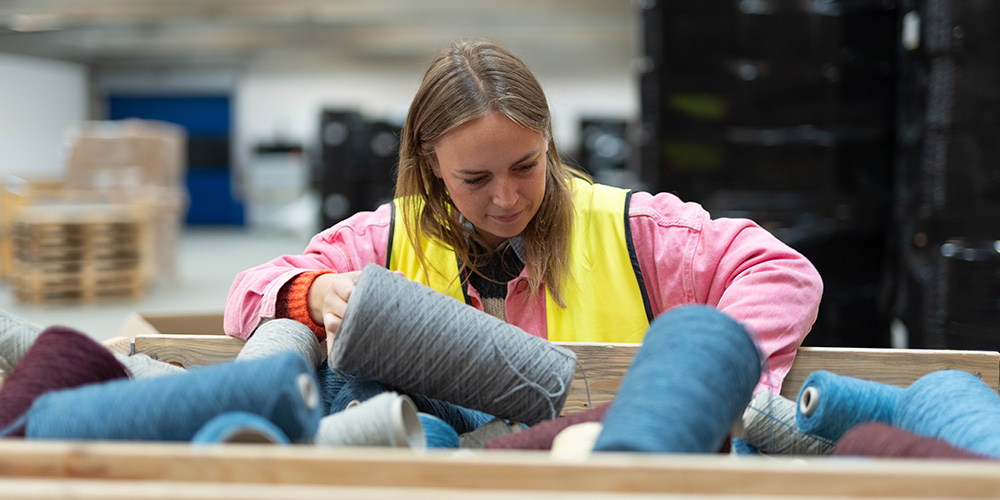
Lea from Hos Regina is a talented macramé artist and the happy receiver of some of our residual yarn
Category intent according to the Cradle to Cradle Certified® Product Standard Version 4.0.:
Product manufacturing results in a positive impact on air quality, the renewable energy supply, and the balance of climate changing greenhouse gases.

The Cradle to Cradle Certified® User Guidance outlines several requirements in this category that must be met on the different certification levels. It is assessed that the final manufacturing stage facilities are in compliance with all applicable laws and regulations and/or industry best practice related to air emissions limitations.
Further, electricity use and greenhouse gas emissions associated with final manufacturing and the product’s embodied greenhouse gas emissions have been quantified and verified, creating a baseline against which reductions can be measured, and helping to identify areas for improvement.
See data on our scope 1, 2 and 3 emissions in our ESG reporting.
In addition to calculating the greenhouse gas emissions on a company level, we have also invested in a comprehensive Life Cycle Assessment (LCA) of both our Colortec and Axminster carpets, made by external LCA specialists.
A Life Cycle Assessment is a comprehensive methodology used to evaluate the environmental impacts associated with a product throughout its entire life cycle – from raw material extraction, manufacturing, and use, to disposal or recycling.
In the construction industry, LCA is commonly employed to assess the environmental footprint of primary construction materials, helping stakeholders make informed decisions for sustainable building practices. It encompasses a comprehensive analysis of resource consumption, energy use, emissions, and waste generation associated with a product’s life cycle. By considering these factors, LCA provides a holistic understanding of the environmental implications of a given product.
By quantifying the environmental impacts across different life cycle stages, LCA assists in identifying areas for improvement, guiding the development of more sustainable and eco-friendly alternatives.
Based on the LCAs, we have introduced third party verified Environmental Product Declarations (EPDs) for our Colortec carpet solutions.

An Environmental Product Declaration is a standardised document providing comprehensive data about the environmental performance of a product throughout its life cycle. This declaration encapsulates the essence of the Life Cycle Assessment.
An EPD provides credits in green building schemes but cannot stand alone. It is important to assess the method and data on which an EPD is based. Therefore, it can proof difficult to compare different products on the basis of an EPD.
How does Cradle to Cradle Certified® compare to material transparency documents?
Cradle to Cradle Certified® is not a transparency document, it is a framework for optimization. Cradle to Cradle Certified goes beyond a simple inventory and/or screening of chemicals. After screening every chemical ingredient in a product down to at least 100 parts per million (.01% of the ingredient) against our Restricted Substances List, an accredited professional assesses the chemicals in the product to ensure they are healthy for people and the environment.
Rather than a self-disclosed list of ingredients, Cradle to Cradle Certified products have been inventoried, screened, and assessed for human and environmental health by an accredited 3rd party.
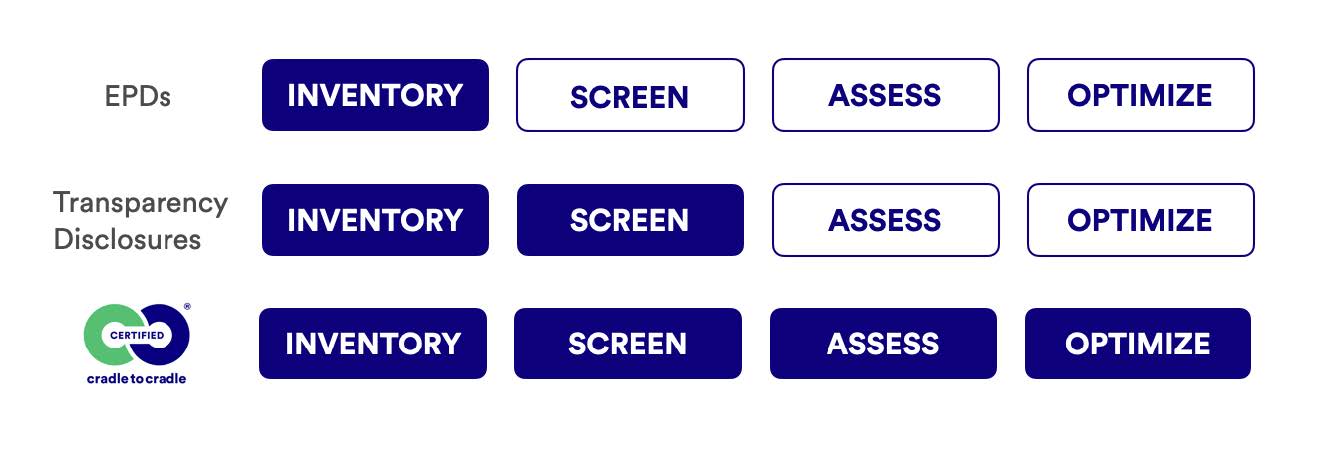
The intent of the Cradle to Cradle certification related to the development of a strategy for clean air and climate protection is to incorporate objectives in accordance with international climate science. It aims to establish goals that pave the way for an increased utilisation of renewable energy in the product manufacturing process, while simultaneously decreasing or offsetting greenhouse gas emissions. Furthermore, at the gold level of certification, the embodied emissions throughout the product’s life cycle are also addressed.
Our Clean Air & Climate Protection strategy encompasses the following areas:
We are committed to expanding our business while maintaining a strong focus on environmental sustainability. Our objective is to achieve decoupling of growth from environmental impact, ensuring that the growth of our business does not lead to an increase in CO2 emissions. We aim to achieve a harmonious balance between economic growth and environmental responsibility.
We source 100% of the electricity used at the final manufacturing stages from renewable wind energy. To address the remaining emissions resulting from the use of natural gas in certain production processes, we offset 50% through the purchase of GOLD Standard Verified Emission Reductions. Our support is directed towards a wind turbine project in Madhya Pradesh, India. Recognising that relying solely on offsetting is not a solution, our foremost commitment lies in reducing our own emissions. However, we consider offset purchases as an additional means to actively contribute to the global reduction of CO2 emissions.
Category intent according to the Cradle to Cradle Certified® Product Standard Version 4.0.:
Water and soil are treated as precious and shared resources. Watersheds and soil ecosystems are protected and clean water and healthy soils are available to people and other organisms.
As in the other categories of the Cradle to Cradle certification, the User Guidance outlines several requirements under “Water & Soil Stewardship” that have to be met on the different certification levels.
Basically, through the assessment and understanding of water- and soil-related impacts attributable to the product, including local water availability and quality issues relevant to the product’s manufacturing facilities, opportunities to address the impacts are identified.
Our assessment body, Vugge til Vugge, has evaluated risks related to both water quantity and quality. This includes ensuring that the final manufacturing stages and select supplier facilities are in compliance with regulatory and/or industry best practice effluent limitations.
Water withdrawals, discharge, and consumption at final manufacturing facilities of the certified products are quantified, creating a baseline against which reductions can be measured, and helping to identify areas for improvement.
The production processes of Dansk Wilton carpets are not associated with any high-volume water consumption in the final manufacturing stages.
Besides assessing activities related to the manufacturing stages of our carpets, we evaluate the supply chain and opportunities to enhance water and soil quality related to the product’s primary raw materials and processes.
The Cradle to Cradle certification mandates companies to address challenges and opportunities tied to raw materials constituting over 25% of a product.
Given that wool is a fundamental raw material in our carpets, it holds a prominent place in our strategy for water and soil stewardship, aligning with opportunities in both wool and yarn production.
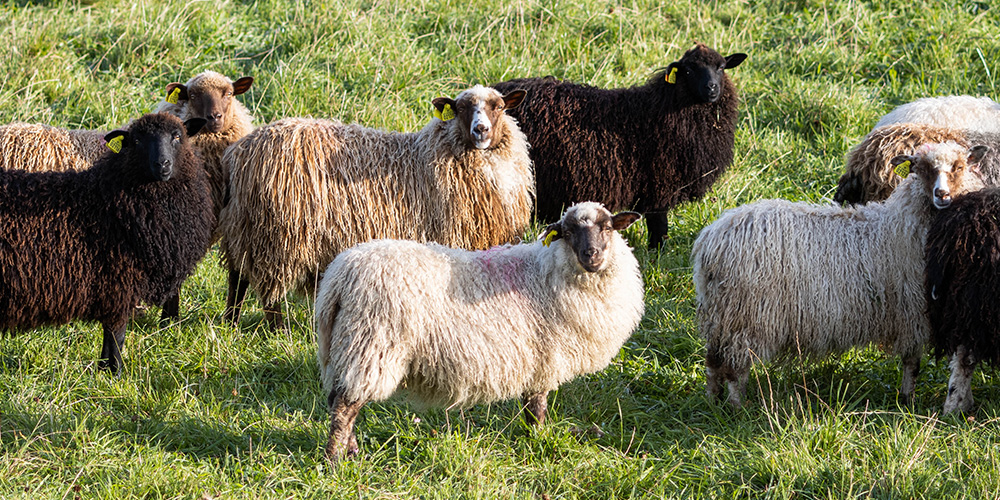
Wool demonstrates several favorable characteristics for interior design solutions, including high quality carpets. Wool is durable, contributes positively to indoor air quality, and carries emotional appeal, rendering it a suitable choice in consonance with our dedication to longevity and environmental responsibility. Wool possesses inherent fire resistance, eliminating the need for additional fire retardants to meet stringent fire safety standards. Wool stands out as a natural and rapidly renewable resource and is free from the association with microplastics frequently present in synthetic fibers.
We acknowledge there are certain issues associated with wool and we are committed to addressing these matters and pursuing positive impact. This includes considerations for animal welfare, freshwater resource impact, land use, risks associated with traditional farming, greenhouse gas emissions, and the potential impact of overgrasing on biodiversity and soil quality. These are issues beyond our direct control and not within our company’s ability to solve. However, we can play a role in fostering positive development.
Improvements in water and soil conditions will also result from material health optimisations related to yarn production. Our ORIGIN concept, which is based on undyed yarn, is an example of such optimisation, eliminating the dyes.
Our primary objective is to achieve the silver level in the Material Health and Water & Soil Stewardship categories for all our carpet qualities within the Cradle to Cradle certification framework. Ultimately, we aim to advance to the gold level.
The emphasis of the Cradle to Cradle certification on animal welfare is distinct, treated not as one of the 5 categories but as a separate point with specific requirements. Given the significance of wool as a resource for Dansk Wilton, our animal welfare policy clearly details our requirements and expectations concerning the well-being of the sheep from which we source wool.
Sheep farming, by nature, involves animals residing outdoors in expansive areas, and shearing is an essential practice to ensure the animals’ well-being and survival.
Several countries with robust traditions in wool production already have established legislation and controls on animal welfare issues, as seen in the United Kingdom and New Zealand, while other countries lack similarly stringent requirements. Our objective is to ensure an increased level of documentation and, where feasible, certification or another form of third-party verification, irrespective of the wool’s origin.
A challenge linked to such third-party verification, especially in areas lacking legislation and regulatory oversight, is the absence of traceability back to individual farms, particularly in scenarios where numerous small sheep farmers contribute wool to a centralised wool exchange for collection before resale.
We underline our commitment to responsible animal husbandry and to uphold a high standard of animal welfare for the wool we procure. Consequently, this aspect forms an integral part of our discussions with yarn suppliers and wool subcontractors.
The Social Fairness category within the Cradle to Cradle Certified® framework is designed to promote advancements in maintaining business operations that safeguard social fairness in the value chain.
It strives to uphold the interests of all stakeholders, encompassing employees across the value chain, customers, community members, and the environment. The certification covers the following points aiming at fostering a business culture of social fairness:

Ensuring compliance with human rights and labor rights within our company facility remains a top priority, and we consistently strive to uphold the highest standards for workplace health and safety, encompassing both mental and physical wellbeing.
As part of the Cradle to Cradle certification, we meticulously review and complete a questionnaire comprising nearly 100 questions related to human rights, labor rights, health & safety, and anti-corruption. Each response to the questionnaire is thoroughly documented, and an audit at our facility is conducted by our assessor, Vugge til Vugge.
The questions in the questionnaire align with the UN Global Compact’s ”Communication on Progress” but are reinforced by comprehensive documentation to ensure compliance.
For our internal key performance indicators on social responsibility, we refer to our ESG reporting.

Dansk Wilton has implemented a whistleblower scheme accessible to both our internal employees and external stakeholders. This enables individuals within our value chain to raise concerns related to our activities.
All submissions to the whistleblower program are documented and handled in accordance with globally recognised human rights and standards, including the UN Declaration of Human Rights and ILO Conventions. The internal program adheres to Danish labor rights legislation, while the external program operates on a voluntary basis.
Through this initiative, we offer a channel for reporting issues within Dansk Wilton and our value chain that contradict Dansk Wilton’s policies and international guidelines.
The whistleblower scheme is accessible here.
Dansk Wilton maintains enduring business collaborations with a select number of direct suppliers, who are all located in Europe.
We firmly believe that optimal results and the attainment of our objectives can only be realised through strong and effective collaboration with our suppliers. Every direct supplier adheres to our supplier code of conduct and provides comprehensive and detailed data relevant to our Cradle to Cradle certification. Without their cooperation, certifying our carpets would not be possible.
Europe is inherently not linked with high risks concerning human and labour rights. However, it is necessary to delve deeper to uncover any potential risks associated with the manufacturing of our carpets.
In our approach to risk assessment within our value chain, we undertake a comprehensive examination that extends beyond the mere location of our suppliers. We also examine the country of origin for our raw materials and components. This dual focus allows us to gain a holistic understanding of potential risks and challenges embedded within our supply network.
It is imperative to note that this distinction is often overlooked, contributing to confusion in the assessment process. While some manufacturers readily disclose information pertaining to the supplier country, the crucial details surrounding the country of origin for raw materials and components are not always made transparent. This distinction is vital, as it enables us to scrutinise and manage risks more effectively, ensuring a resilient and ethically sound supply chain.
The thorough risk assessment is done in collaboration with an external partner with experience in human rights and due diligence in the textile industry to ensure compliance with best practice and highest international standards.
By adopting this nuanced approach, we aim to strengthen our commitment to transparency, ethical sourcing, and risk mitigation throughout our value chain.

The Cradle to Cradle certification is renowned for its ambitious standards across all certification aspects, also within the social fairness category. By stipulating requirements for companies to participate in positive impact projects related to social fairness, the framework encourages businesses to shoulder social responsibility aligned with their activities.
Dansk Wilton has been a consistent partner with the organisation ”High:five” for several years, dedicating efforts to secure employment for young individuals at risk of crime and those with a history of penalisation, aiding their re-socialisation through regular jobs or educational opportunities.
In 2023, we expanded our commitment to include young people from “Ungdomscenter Knudmosen,” a specialised youth education program in Herning Municipality for individuals aged 16 to 25 facing challenges that hinder their progress in the education system or labor market without support.
Both projects share the common goal of assisting young people with challenging conditions in creating a better and more meaningful life for themselves. Dansk Wilton’s motivation behind these positive social impact projects is to provide support to young individuals facing difficulties, offering them an opportunity to develop skills and secure employment, benefiting local companies and the municipality.
Our focus is on young people who can benefit from employment in a production company, where formal education is not a prerequisite, catering to those who either choose not to pursue education or face challenges preventing them from completing it.
Both initiatives have yielded positive outcomes, not only for the young individuals integrated into the company but also for the company itself and its other employees. Many of the young individuals we’ve embraced have secured long-term employment at Dansk Wilton, resulting in mutual advantages.
We aim to sustain the positive collaboration with both High:five and Knudmosen. We remain open to partnerships with the municipality and other organisations dedicated to enhancing opportunities for disadvantaged young people.
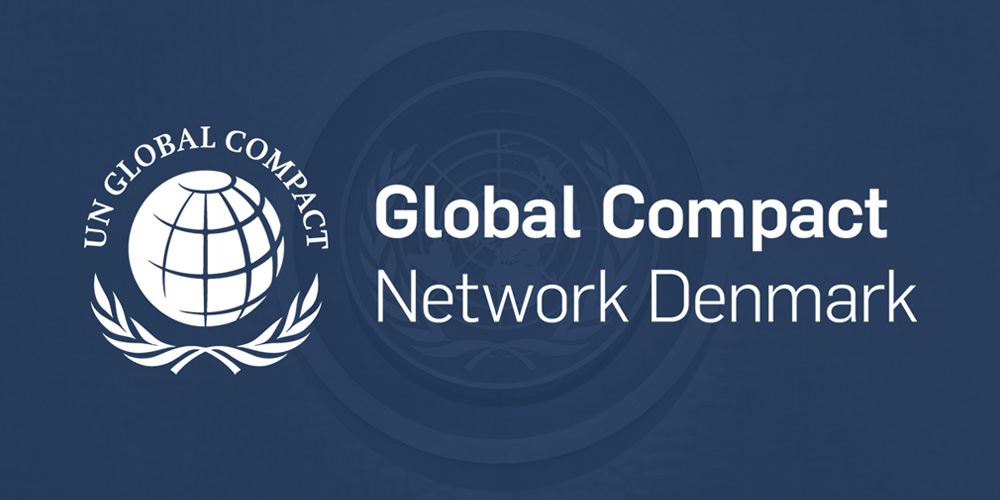
Dansk Wilton is part of the UN Global Network Denmark and we support the ”10 Principles.” The UN Global Compact’s ”Communication on Progress” (COP) is a reporting mechanism through which participating companies and organisations communicate their progress in implementing the ten principles of the Global Compact.
At Dansk Wilton, the 10 principles and our Cradle to Cradle certification are intricately interconnected, both contributing to a shared objective. While the 10 principles primarily establish guidelines and norms, the Cradle to Cradle certification translates these principles into strategies and actions.
The 10 principles of the UN Global Compact serve as a guideline for integrating sustainability and responsible business practices into corporate strategies and is also linked to ESG reporting (Environmental, Social, Governance):
Environmental – Principles 7 8 9
Businesses should:
Social – Principles 1 2 3 4 5 6
Businesses should:
Governance – Principle 10
Businesses should:
To us, Cradle to Cradle is more than a certification – it is our tool and guideline within each area of certification: Material health, Product circularity, Clean air and climate protection, Water and soil stewardship, and Social fairness.
In our belief, this holistic approach is what makes Cradle to Cradle the most ambitious and comprehensive certification programme within social and environmental responsibility. Cradle to Cradle Certified® requires continual improvement in products and processes. We are committed to go further all the time.
In short, our efforts can be summed up in the overview on the chart:

Rethink
A Decisive Step.
Our journey towards a sustainable world is target oriented, with a strong focus on rethinking what we do.
We want to support the international hospitality industry with carpet solutions that are produced responsibly with consideration for both people and the environment.
We have set ourselves a goal and taken a decisive step towards a more sustainable future.

Act
Step by Step.
Dansk Wilton’s business strategy is based on the principles of the Cradle to Cradle approach.
Sustainability is a journey with the aim to make steady progress. It is always possible to improve. So that is what we aim to do in line with the Cradle to Cradle philosophy.
It is not just something we talk about; it is something we act upon.
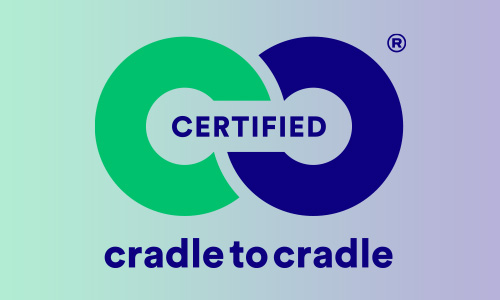
Cradle to Cradle
An Ambitious Step.
The hospitality industry, whether on land or at sea, places significant emphasis on conscientious consumption practices, with Cradle to Cradle Certified® standing out as one of the foremost product standards in this area.
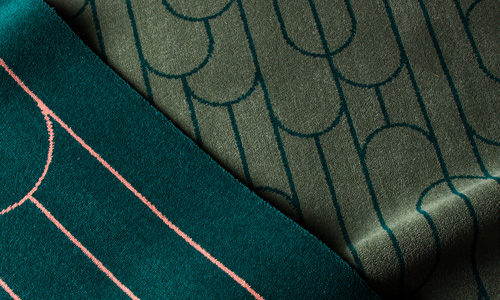
Axminster and Colortec
The Right Step.
With the Cradle to Cradle certification of our Axminster and Colortec carpet solutions we have achieved strong and visible recognition of our concentrated efforts to run our business sustainably.
Dansk Wilton A/S, defined as Small and Medium Sized Enterprise (SME), is not yet subject to implementing the Corporate Sustainability Reporting Directive (CSRD) introduced by the EU and further defined by the European Social Reporting Standard (ESRS). However, we want to report on our focus areas, efforts, challenges, and opportunities within the broad spectrum of sustainability, not only in numbers, but supported by description of our activities.
This reporting is built around our Cradle to Cradle certification, which forms the framework for our actions, strategies and objectives. This approach also aligns with the “Communication on Progress” reporting we make as a member of the UN Global Compact Network Denmark.
If you would like to know more about the Cradle to Cradle certification of our carpet solutions or would like to book a meeting for you and your team to gain more knowledge on the certification, we are more than happy to support you.
Social fairness
Category intent according to the Cradle to Cradle Certified® Product Standard Version 4.0.:
Companies are committed to upholding human rights and applying fair and equitable business practices.